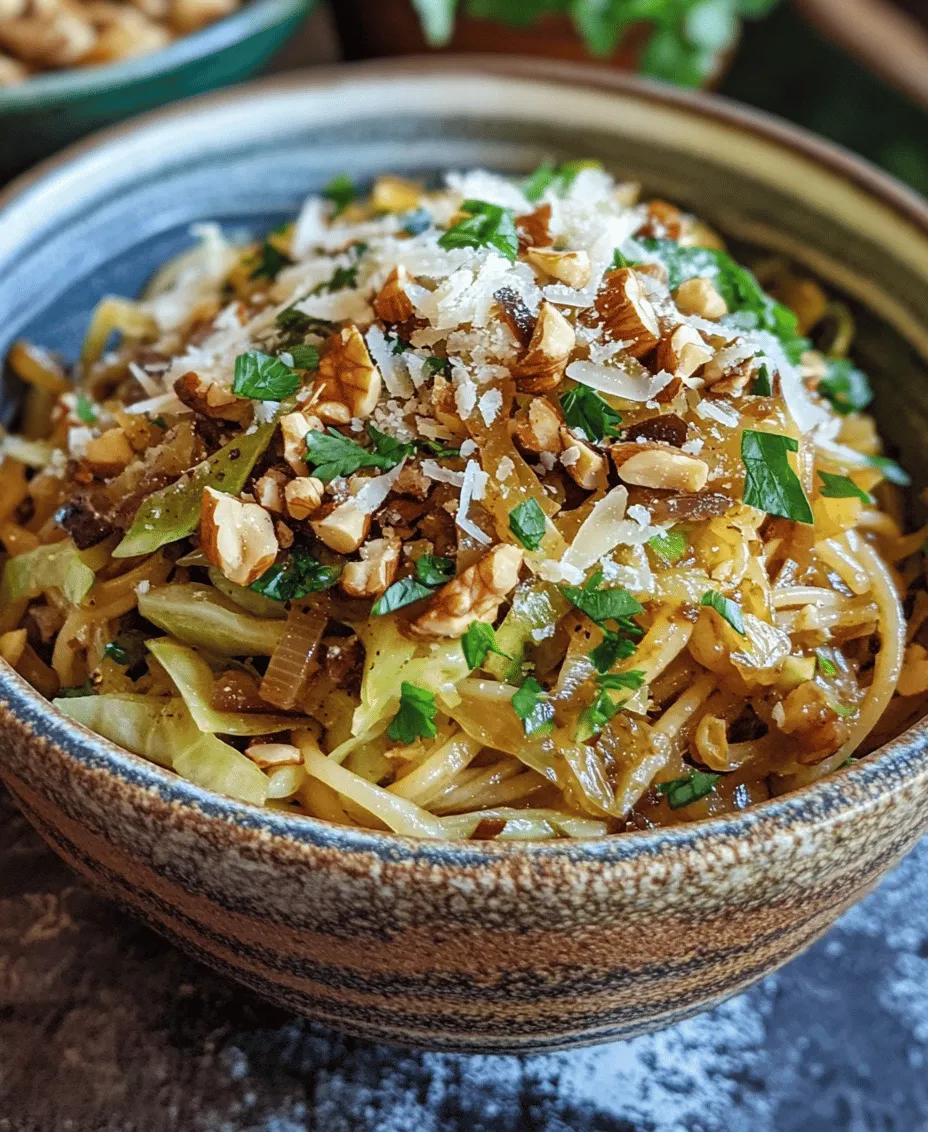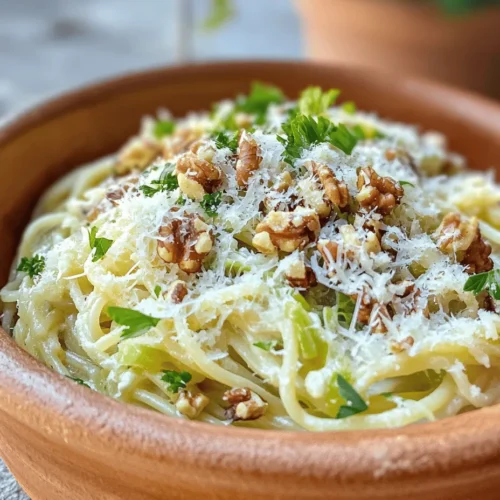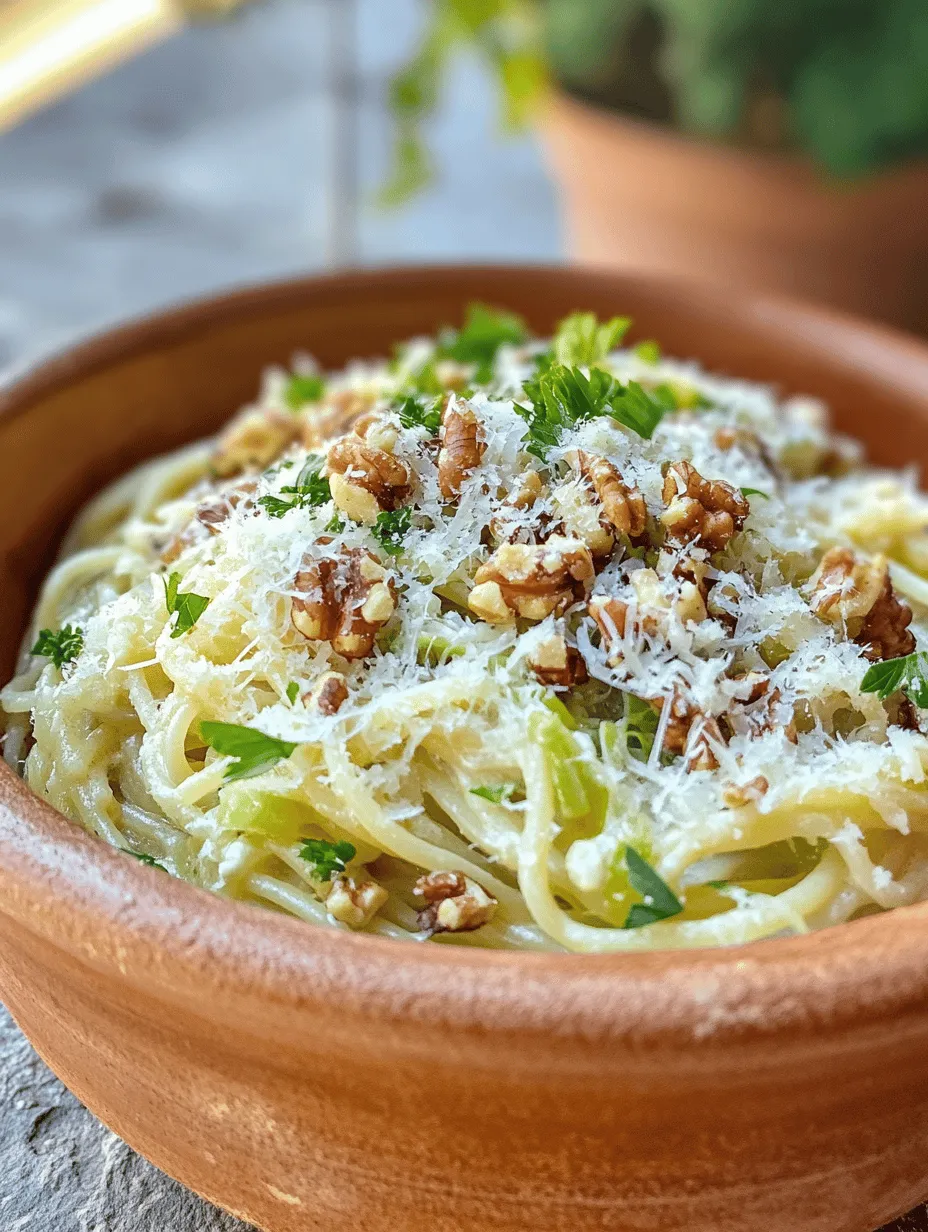Introduction
Cabbage Walnut Pasta is a unique and flavorful dish that combines the earthiness of sautéed cabbage with the rich crunch of walnuts, all enveloped in perfectly cooked pasta. This recipe stands out not only for its delightful taste but also for its simplicity and quick preparation time, making it an ideal choice for busy weeknight dinners or a nourishing meal anytime you crave something wholesome.
The main ingredients in this dish—cabbage, walnuts, garlic, and olive oil—offer an array of nutritional benefits that appeal to a variety of dietary preferences. Cabbage, a cruciferous vegetable, is packed with vitamins K and C, and is an excellent source of dietary fiber. Walnuts, on the other hand, are rich in healthy fats, protein, and antioxidants, making them a perfect addition to any meal for those seeking heart-healthy options.
For those who follow vegetarian or vegan diets, this recipe is incredibly versatile. It can be easily adapted to meet specific dietary needs, such as substituting traditional cheese with nutritional yeast for a dairy-free experience, while still providing a savory depth that makes the dish satisfying and delicious. With its combination of flavors and textures, Cabbage Walnut Pasta will surely become a favorite for anyone who tries it.
Understanding the Ingredients
The success of Cabbage Walnut Pasta lies in the quality and combination of its ingredients. Let’s take a closer look at each of the main components:
Cabbage
Cabbage is the star of this dish, delivering a wonderful texture and flavor profile. This vegetable is low in calories but high in nutrients, offering a host of health benefits. It is particularly known for its high vitamin K content, which is essential for blood clotting and bone health. Additionally, cabbage is a good source of vitamin C, which supports the immune system, and it provides ample fiber, aiding in digestion and promoting a healthy gut.
When cooked, cabbage takes on a sweet, caramelized flavor that enhances the overall taste of the pasta. Its ability to absorb flavors makes it an excellent base for this dish, allowing it to meld beautifully with the other ingredients.
Walnuts
Walnuts add a delightful crunch to Cabbage Walnut Pasta, complementing the soft texture of the sautéed cabbage. They are not only delicious but also incredibly nutritious. Walnuts are high in omega-3 fatty acids, which are essential for heart health and brain function. They also provide a good source of protein, making this dish a satisfying option for those looking to increase their protein intake.
In addition to their health benefits, walnuts have a rich, buttery flavor that enhances the overall dish. When toasted, they release their oils and deepen their flavor profile, making them a fantastic addition to the pasta.
Olive Oil
Olive oil is the preferred fat in this recipe, serving as a cooking medium that adds richness and enhances flavor. Known for its heart-healthy monounsaturated fats, olive oil is a staple in Mediterranean cuisine and is linked to numerous health benefits, including reduced inflammation and improved heart health.
Using high-quality extra virgin olive oil not only elevates the taste of the dish but also contributes to its nutritional content. The oil helps in sautéing the garlic and onions, ensuring they release their flavors effectively while adding a smooth finish to the pasta.
Garlic and Onion
Garlic and onion are foundational aromatics in this recipe, playing a crucial role in building flavor. Garlic is renowned for its health benefits, including its potential to boost the immune system and reduce blood pressure. It imparts a savory aroma and a hint of sweetness when sautéed, making it a perfect complement to the other ingredients.
Onions, similarly, add depth and sweetness through caramelization. When cooked slowly, they transform from sharp and pungent to sweet and mellow, creating a complex flavor base that enhances the overall dish. Together, garlic and onion form a flavorful foundation that makes the Cabbage Walnut Pasta irresistible.
Cheese or Nutritional Yeast
For those who enjoy cheese, a sprinkle of grated Parmesan or Pecorino Romano can elevate the dish with a savory, umami kick. However, for those following a vegan diet or looking to reduce dairy intake, nutritional yeast is an excellent alternative. It has a cheesy flavor and is loaded with B vitamins, making it a nutritious addition that enhances the dish without compromising on taste.
Incorporating cheese or nutritional yeast not only adds flavor but also contributes creaminess to the pasta, helping to bind the ingredients together and create a cohesive dish.
Step-by-Step Cooking Process
Now that we’ve explored the ingredients, let’s delve into the step-by-step process of preparing Cabbage Walnut Pasta. This simple yet satisfying recipe is designed to be easy to follow, ensuring that even novice cooks can create a delicious meal in no time.
Step 1: Cooking the Pasta
Begin by bringing a large pot of salted water to a boil. The salt enhances the pasta’s flavor, so don’t skip this crucial step. Once the water is boiling, add your choice of pasta—spaghetti, fettuccine, or any other type you prefer.
Tip for Perfect Pasta: To achieve the ideal al dente texture, refer to the cooking instructions on the pasta package. As a general rule, cook the pasta for about 1-2 minutes less than the recommended time. This way, it will finish cooking in the next step when combined with the sautéed ingredients.
Step 2: Sautéing the Aromatics
While the pasta is cooking, heat a generous amount of olive oil in a large skillet over medium heat. Once the oil is shimmering, add finely chopped onions and sauté for about 3-4 minutes, or until they become translucent. This process releases their natural sweetness and adds depth to the dish.
Next, add minced garlic to the pan and sauté for an additional minute. Be careful not to let the garlic burn, as burnt garlic can impart a bitter taste. Stir frequently to ensure even cooking and prevent sticking.
Step 3: Caramelizing the Cabbage
Once the onions and garlic are fragrant and softened, it’s time to add the chopped cabbage. Stir well to combine, and let the cabbage cook for approximately 5-7 minutes. The goal is to caramelize the cabbage, which brings out its natural sugars and creates a sweet, rich flavor.
Importance of Caramelizing Cabbage: This step is crucial as it transforms the texture and taste of the cabbage, making it tender and flavorful. Stir occasionally, allowing the cabbage to brown slightly, which enhances its sweetness and adds complexity to the dish.
Step 4: Adding the Walnuts
After the cabbage has caramelized, it’s time to add the walnuts. Toasted walnuts provide an essential crunch and depth of flavor. If you haven’t already toasted them, simply add them to the skillet and stir well, allowing them to warm through for 2-3 minutes. This step enhances their nutty flavor and encourages the release of healthy oils.
Step 5: Combining the Ingredients
Once the pasta has finished cooking, be sure to reserve a cup of the pasta cooking water before draining it. This starchy water can be useful for adjusting the sauce’s consistency later.
Add the drained pasta directly to the skillet with the sautéed cabbage, onions, garlic, and walnuts. Toss everything together gently, ensuring the pasta is well coated with the flavorful mixture. If the pasta seems dry, gradually add some reserved pasta water until you reach your desired consistency.
With these steps, you are well on your way to creating a delicious and nutritious Cabbage Walnut Pasta that showcases the wonderful interplay of flavors and textures. This dish not only satisfies the palate but also nourishes the body, making it a perfect addition to your culinary repertoire.
Stay tuned for more tips and insights on perfecting this recipe and making it your own!

Tips for Combining Pasta and Sauce to Achieve the Perfect Consistency
To create a harmonious dish of Cabbage Walnut Pasta, the key lies in the perfect marriage of pasta and sauce. Here are some essential tips to ensure your pasta is coated evenly and the flavors meld beautifully:
1. Reserve Pasta Water: Before draining your pasta, save a cup of the cooking water. This starchy liquid can be added to the sauce to achieve the desired consistency. Start by adding a few tablespoons to the sauce and stirring well; continue adding until you reach your preferred thickness.
2. Timing is Everything: Combine the pasta and sauce while the pasta is still hot. This helps the sauce adhere better to the pasta. Toss the drained pasta directly into the skillet with the sauce, allowing the heat to work its magic.
3. Gentle Tossing: When mixing the pasta with the sauce, use a gentle folding motion rather than vigorous stirring. This prevents the pasta from breaking and ensures an even distribution of the sauce.
4. Adjust Consistency: If you find your sauce is too thick after mixing, don’t hesitate to incorporate more reserved pasta water gradually. This can help create a silky texture that clings to each strand of pasta.
Flavor Enhancements and Variations
While the basic Cabbage Walnut Pasta recipe is delicious as is, there are many ways to tweak and elevate the flavors to suit your preferences:
Adjusting Spice Levels
If you enjoy a bit of heat, consider adding crushed red pepper flakes. Start with a small pinch and gradually increase the amount to suit your taste. This addition not only elevates the flavor profile but also enhances the dish’s overall warmth.
Complementary Vegetables
Incorporating additional vegetables can add color, texture, and nutritional value to your pasta. Here are some excellent choices:
– Bell Peppers: Slice and sauté bell peppers alongside the cabbage for a sweet, crunchy addition.
– Spinach: Toss in fresh spinach just before serving. Its slight wilting adds a vibrant green color and boosts the dish’s nutrient content.
– Carrots: Shredded carrots can add a touch of sweetness and a lovely crunch.
Alternative Nuts or Seeds
For those looking for a different texture or taste, consider substituting walnuts with other nuts or seeds:
– Pine Nuts: These provide a soft texture and a slightly sweet flavor that pairs beautifully with the dish.
– Sunflower Seeds: For a nut-free alternative, sunflower seeds offer a crunchy bite and are perfect for those with nut allergies.
– Pistachios: Chopped pistachios can add a unique flavor and a pop of color.
Dietary Variations
Cabbage Walnut Pasta is naturally vegetarian, but you can easily adapt it for other dietary needs:
– Gluten-Free Pasta: Use gluten-free pasta varieties made from rice, quinoa, or lentils. These options maintain a delicious flavor and texture.
– Nut-Free Alternatives: Substitute walnuts with toasted pumpkin seeds or omit nuts altogether for those with nut allergies.
Serving Suggestions
Serving your Cabbage Walnut Pasta can enhance its appeal and satisfaction. Here are some ideas to elevate your dining experience:
1. Garnishing: A sprinkle of chopped fresh parsley or basil adds a burst of color and freshness to the dish. Consider adding a drizzle of olive oil just before serving for extra richness.
2. Pairing Recommendations:
– Side Dishes: Serve with a light arugula salad dressed with lemon vinaigrette to complement the pasta’s flavors.
– Wine Pairings: A crisp white wine, such as Sauvignon Blanc or a light red like Pinot Noir, can enhance the meal. The acidity in the wine balances the richness of the walnuts and the sweetness of the cabbage.
– Bread: Crusty artisan bread or garlic bread can make a delightful accompaniment for soaking up any leftover sauce.
3. Meal Prepping and Storing Leftovers:
– Storing: If you have leftovers, store them in an airtight container in the refrigerator for up to three days.
– Reheating: To maintain texture, reheat gently in a skillet over low heat. Add a splash of reserved pasta water to bring the dish back to life.
Nutritional Information
Understanding the nutritional content of your Cabbage Walnut Pasta can help you appreciate its health benefits:
– Calories: Approximately 400 calories per serving, depending on portion size and specific ingredients used.
– Protein: Each serving provides around 12 grams of protein, thanks to the nuts and pasta.
– Fats: The dish contains healthy fats primarily from walnuts, contributing to heart health.
– Carbohydrates: With about 60 grams of carbohydrates per serving, this pasta dish provides a good source of energy.
This recipe fits well into a balanced diet, offering a variety of nutrients while remaining vegetarian and easily adaptable for vegan diets. The presence of cabbage adds fiber, vitamins C and K, and antioxidants, making this dish not only delicious but also nourishing.
Conclusion
Cabbage Walnut Pasta is a simple yet flavorful dish that embodies the beauty of fresh ingredients and straightforward cooking techniques. Its health benefits, versatility, and ease of preparation make it an excellent choice for weeknight dinners or special occasions.
We encourage you to try this recipe, explore its customizable options, and savor the delightful flavors that come together in each bite. Whether enjoyed as a solo dish or as part of a larger meal, Cabbage Walnut Pasta is sure to impress and satisfy any palate. Embrace its versatility, and let it become a favorite in your culinary repertoire!


